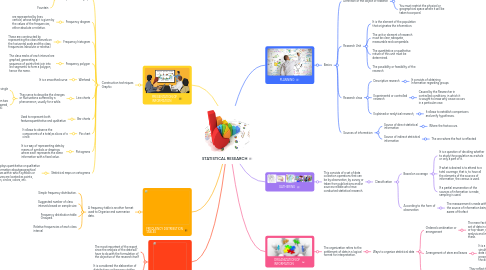
1. PRESENTATION OF INFORMATION
1.1. Construction techniques Graphic
1.1.1. Components of a graph
1.1.1.1. Escala Fuente
1.1.1.2. Scale
1.1.1.3. Fountain
1.1.2. Frequency diagram
1.1.2.1. are represented by lines vertical, whose height is given by the values of the frequencies, either absolute or relative.
1.1.3. Frequency histogram
1.1.3.1. These are constructed by representing the class intervals on the horizontal scale and the class frequencies (absolute or relative).
1.1.4. Frequency polygon
1.1.4.1. The class marks of each interval are graphed, generating a sequence of points that join into line segments to form a polygon, hence the name.
1.1.5. Warhead
1.1.5.1. It is a smoothed curve
1.1.6. Line charts
1.1.6.1. They serve to describe the changes or fluctuations suffered by a phenomenon, usually for a while.
1.1.6.1.1. They can be simple, when a single series of data is drawn
1.1.6.1.2. They can be composite, when two or more data series are compared, usually over time (time series).
1.1.7. Bar charts
1.1.7.1. Used to represent both featuresquantitative and qualitative
1.1.8. Pie chart
1.1.8.1. It allows to observe the components of a total,as slices of a circle
1.1.9. Pictograms
1.1.9.1. It is a way of representing data by means of symbols or drawings where each represents the same information with a fixed value.
1.1.10. Statistical maps or cartograms
1.1.10.1. Displays quantitative or qualitative information aboutgeographical bases within which symbols or figures are located as points, bars, circles, colors, etc.
2. FREQUENCY DISTRIBUTION TABLES
2.1. A frequency table is another format used to Organize and summarize data.
2.1.1. Simple frequency distribution.
2.1.2. Suggested number of class intervals based on sample size
2.1.3. Frequency distribution table Grouped.
2.1.4. Relative frequencies of each class interval
3. Analysis and interpretation
3.1. The most important of the report, since the analysis of the data will have to do with the formulation of the objective of the research itself
3.2. It is considered the elaboration of distributions or frequency tables obtained through a systematization of the information
4. PLANNING
4.1. Basics
4.1.1. Definition of the object of research
4.1.1.1. You must answer the what, the how, and set the right time for become
4.1.1.2. You must restrict the physical or geographical space where it will be taken tocorporal.
4.1.2. Research Unit
4.1.2.1. It is the element of the population that originates the information.
4.1.2.2. The unit or element of research must be clear, adequate, measurable and comparable.
4.1.2.3. The quantitative or qualitative nature of this unit must be determined.
4.1.2.4. The possibility or feasibility of the research
4.1.3. Research class
4.1.3.1. Descriptive research
4.1.3.1.1. It consists of obtaining Information regarding groups
4.1.3.2. Experimental or controlled research
4.1.3.2.1. Caused by the Researcher in controlled conditions, in which it is sought to know why cause occurs in a particular case
4.1.3.3. Explained or analytical research,
4.1.3.3.1. It allows to establish comparisons and verify hypotheses.
4.1.4. Sources of information
4.1.4.1. Source of direct statistical information
4.1.4.1.1. Where the factoccurs.
4.1.4.2. Source of indirect statistical information
4.1.4.2.1. The one where the fact is reflected
5. GATHERING
5.1. This consists of a set of data collection operations that can be by observation, by survey or taken from publications and/or sources reliable who have conducted statistical research.
5.1.1. Classification
5.1.1.1. Based on coverage
5.1.1.1.1. It is a question of deciding whether to study the population as a whole or only a part of it.
5.1.1.1.2. If what is desired is to attend to a total coverage, that is, to have all the elements of the sources of information, the census is used.
5.1.1.1.3. If a partial enumeration of the sources of information is made, sampling is used.
5.1.1.2. According to the form of observation
5.1.1.2.1. The measurement is made without the source of information being aware of thefact
6. ORGANIZATION OF INFORMATION
6.1. The organization refers to the settlement of data in a logical format for interpretation.
6.1.1. Ways to organize statistical data
6.1.1.1. Ordered combination or arrangement
6.1.1.1.1. The mere fact of having ordered a set of data in ascending form or top-down, allows a quick analysis and interpretation of these.
6.1.1.2. Arrangement of stem and leaves
6.1.1.2.1. It is a technique that simultaneously summarizes the data in numerical form and presents a graphical illustration of the distribution.
6.1.1.3. Tabulation of information
6.1.1.3.1. They reflect the statistical series, a succession ofData referring to a phenomenon observed through time and space.
